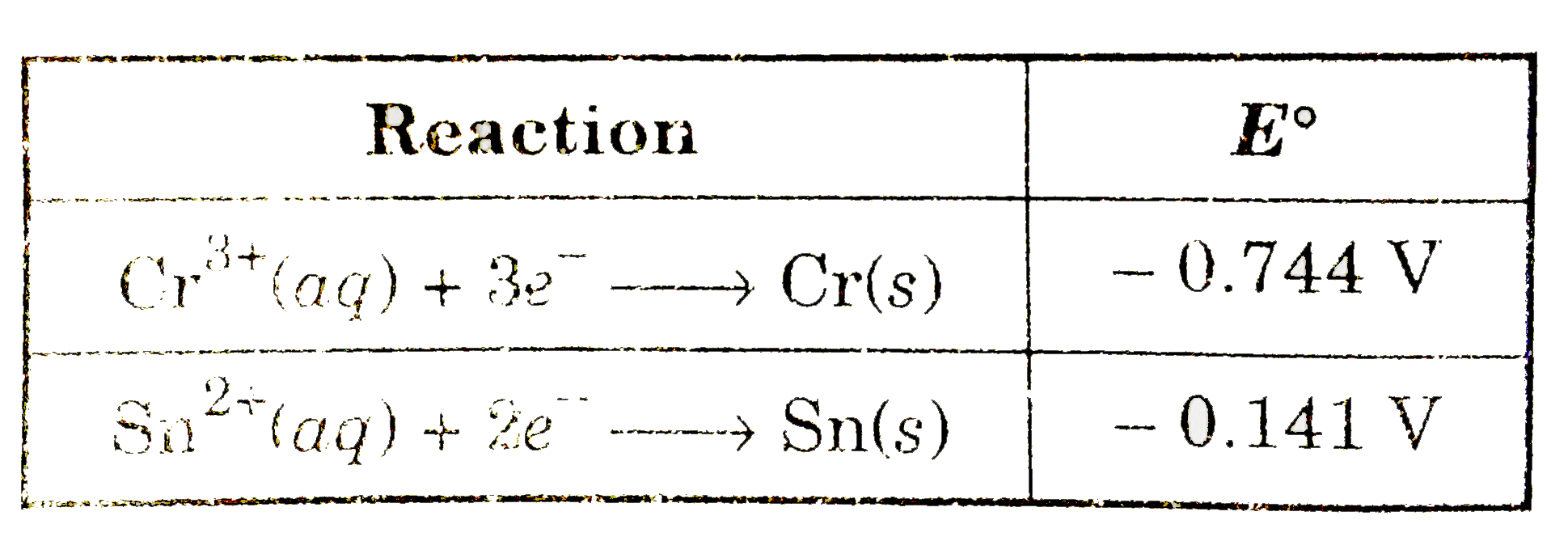Ag+(aq)+e−→Ag(s) E∘=0.80V
Co2+(aq)+2e(−)→Co(s) E∘=−0.28V
Use the standard reduction potentials to determine the standard potential for the reaction:
Co(s)+2Ag+(aq□)→Co2+(aq)+2Ag(s)
0.52V
0.66V
1.08V
1.88V
The correct Answer is:C
Step by step video, text & image solution for Ag^(+)(aq) + e^(-) rightarrow Ag(s) E^(@) = 0.80V Co^(2+)(aq) + 2e(-) rightarrow Co(s) E^(@) = -0.28V Use the standard reduction potentials to determine the standard potential for the reaction: Co(s) + 2Ag^(+)(aq_) rightarrow Co^(2+)(aq) + 2Ag(s) by Chemistry experts to help you in doubts & scoring excellent marks in Class 12 exams.
Updated on:21/07/2023Topper's Solved these Questions
- ELECTROCHEMISTYBook:GRB PUBLICATIONChapter:ELECTROCHEMISTYExercise:Latimer Diagram, concentration cells
Explore 117 Videos
- ELECTROCHEMISTYBook:GRB PUBLICATIONChapter:ELECTROCHEMISTYExercise:Batteries
Explore 10 Videos
- ELECTROCHEMISTYBook:GRB PUBLICATIONChapter:ELECTROCHEMISTYExercise:Subjective type
Explore 39 Videos
- D-BLOCK ELEMENTSBook:GRB PUBLICATIONChapter:D-BLOCK ELEMENTSExercise:Subjective Type
Explore 18 Videos
- ENVIRONMENTAL CHEMISTRY Book:GRB PUBLICATIONChapter:ENVIRONMENTAL CHEMISTRY Exercise:Straight objective type
Explore 40 Videos
Similar Questions
Al3+(aq)+3e−→Al(s) E∘=−1.66V
Cu2+(aq)+2e−→Cu(s) E∘=+0.34V
What voltage is produced under standard conditions by combining the half-reactions witih these standard Electrode Potential?
View SolutionWhat is the standard cell potential for the reaction,
2Cr(s)+3Sn2+(aq)→3Sn(s)+2Cr3+(aq)
given the E∘ values shown?

View Solution
Knowledge Check
Agaq+e−→Ag(s) E69∘)=0.80V
Mg2+(aq)+2e−→Mg(s) E∘=−2.73V
Use the equations above to calcualte the value or ΔG∘0 (in kJ/mol) for the reaction:
Mg(s)+2Ag+(aq)→Mg2+(aq)+2Ag(s)A681B341C−341D−681Use the given standard reduction potentials to determine the reduction potential for this half-reactions.
MnO−4(aq)+3e−+4H+→MnO2(S)+2H2O(l)
 A1.695 VB2.825 VC3.389 VD5.086 V
A1.695 VB2.825 VC3.389 VD5.086 VSn4+(aq)+2e−→Sn2+(aq) E∘=0.15V
Cr3+(aq)+e−→Cr2+(aq) E∘=0.41V
According to the standard reduction potentials above, what is the value of E∘ for the reaction below?
2Cr3+(aq)+Sn2+(aq)→2Cr2+(aq)+Sn4+(aq)A−0.97VB−0.56VC+0.56VD+0.97V
Ag+(aq)+e−→Ag(s)E∘=0.80V
Cu2+(aq)+2e−→Cu(s)E∘=0.34V

Which increases immediately if the surface area of the silver electrode is increased?
View SolutionUse the standard reduction potentials:
Sn2+(aq)+2e−→Sn(s) E∘=−0.141V
Ag+(aq)+e−→Ag(s) E∘=0.800V
To calcultate E∘ for the reaction:
Sn(s)+2Ag+(aq)→Sn2+(aq)+2Ag(s)
View SolutionNickel metal is added to a solution containign 1.0 m Pb2+(aq) and 1.0MCd^(2+)(aq).Usethestandardreductionpotentials→determinewhichreaction(s)willour.<br>Reaction1:Ni(s) + Pb^(2+)(aq) rightarrow Pb(s) + Ni^(2+)(aq)<br>Reaction2:Ni(s) + Cd^(2+)(aq) rightarrow Cd(s) + Ni^(2+)(aq)<br>{:("Reaction", E^(@)), (Pb^(2+)(aq) + e^(-) rightarrow Pb(s) , -0.13V), (Ni^(2+)(aq) + 2e^(-) rightarrow Ni(s), -0.23V), (Cd^(2+)(aq) + 2e^(-) rightarrow Cd(s), -0.40V):}
View SolutionConsider a volatic cell based on these half -cell :
Ag+(aq.)+e−→Ag(s),E∘=+0.80V
Cd2+(aq)+2e−→Cd(s),E∘=−0.40V
Identify the anode and give the voltage of this cell under standard conditions
View SolutionAg+(aq)+e−→Ag(s)E∘=0.80V
Cu2+(aq)+2e−→Cu(s)E∘=0.34V

Which expression gives the voltage for this cell if [Cu2+]=1.00M and [Ag+]=0.010M?
View Solution

